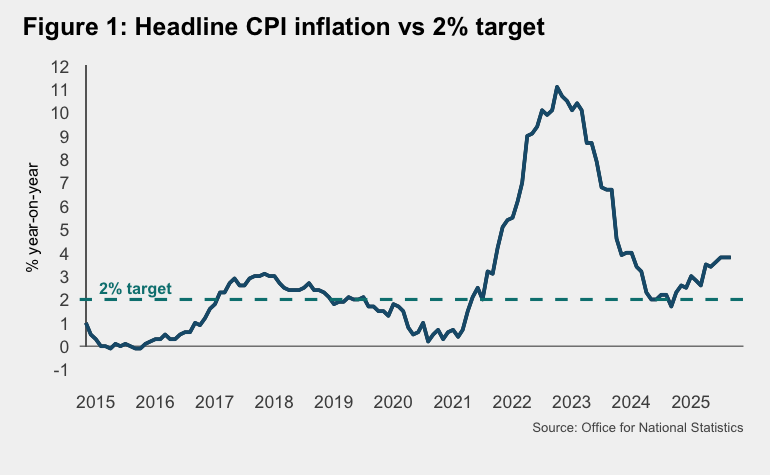The BoE will probably skip a rate cut this week, but a December move is odds on
The Bank of England will likely hold rates this month, but move in December
The outcome of the Bank of England’s Monetary Policy Committee (MPC) meeting on Thursday 6 November looks finely balanced. Softer inflation, easing wage growth, and signs of a cooling labour market have weakened the case for keeping rates elevated much longer. The dovish minority - Swati Dhingra and Alan Taylor, who both backed a cut in September - are likely to gain support from Dave Ramsden and Sarah Breeden. Ramsden has previously dissented in favour of rate cuts and recently warned of labour market fragilities, while Breeden has expressed confidence that inflation remains on track to return to the 2% target despite a temporary “bump in the road.”
Even so, we expect the majority to hold rates steady, choosing to wait for confirmation that the recent disinflationary trend is durable and to assess how the November Budget reshapes the near-term inflation outlook.
A December rate cut, however, is very likely. Until recently, the consensus view was that the Bank had finished cutting rates for 2025. That conviction has weakened since the September CPI print came in below expectations, prompting a partial repricing in money markets. Yet even with implied odds of around 65% for a December move, investors still underestimate how far the balance of risks has shifted towards easing.
Monetary policy remains restrictive: Bank Rate is roughly one percentage point above the BoE’s own central estimate of the “neutral” rate of 3%.[1] With growth sluggish, the labour market softening and inflation surprising on the downside, the case for a further reduction in rates is increasingly compelling. A dovish repricing could lower two-year gilt yields by 15–25bps and see GBP/USD fall below $1.30.
Inflation is overstating underlying pressures
At 3.8%, headline inflation remains above target but exaggerates underlying pressures (Figure 1). The strength of inflation this year reflects legacy cost shocks rather than excess demand.
April brought a one-off surge in regulated and tax-driven costs: energy bills, sewerage charges, Vehicle Excise Duty, bus fares, employer’s National Insurance contributions and the National Living Wage all rose sharply, and VAT was imposed on private school fees. We estimate these factors added roughly one percentage point to headline inflation in September. Stripping out that April jump, price growth in 2025 has been broadly in line with pre-Covid norms (Figure 2).
Recent data have reinforced this disinflationary trend. Headline CPI, services inflation and food price growth in September all came in below the BoE’s August forecast (Figure 3), while the Bank’s preferred measure of underlying services inflation (excluding regulated prices and volatile components) fell to 3.9%, the lowest since early 2022.
Inflation momentum is turning decisively lower
A series of forward-looking indicators now point to further declines in inflation into 2026.
Labour market cooling: Private-sector regular pay growth continues to undershoot the BoE’s projections (Figure 4). Vacancy data point to easing demand for workers and reduced bargaining power, reducing the risk of a wage–price spiral.
Fiscal tightening ahead: We think the November Budget will introduce around £30-£40bn of net tax rises and spending restraint (1%-1.3% of GDP) to restore headroom against fiscal rules, finance targeted giveaways and rebuild fiscal resilience. According to the OBR’s fiscal multipliers and the BoE’s own model sensitivities, a tightening of this scale would justify a 25–50bp reduction in Bank Rate to offset the drag on demand.[2]
Base effects turning favourable: April’s tax and regulated price increases will fall out of the annual CPI calculations early next year, mechanically pulling inflation lower.
Rental pressures easing: The “catch-22” dynamic that saw landlords pass higher interest and mortgage costs onto tenants – helping to keep services inflation stubbornly high – is now reversing.[3] With borrowing rates stabilising and starting to fall, rental inflation has slowed to its lowest pace since late 2022.
Policy still restrictive: Even after one or two rate cuts, monetary policy would remain in what the BoE judges to be restrictive territory. This gives policymakers scope to act without stoking inflation risks.
Together, these dynamics strengthen the case for earlier policy adjustment rather than waiting for clearer evidence of a slowdown in inflation in early 2026.
The MPC’s centre of gravity is shifting
The debate inside the Bank is moving steadily toward when, not whether, to cut. Two members - Swati Dhingra and Alan Taylor - already voted for a reduction in September. Governor Andrew Bailey has since acknowledged that policy has “further to go” on the easing side, citing weak consumption and elevated household saving rates as constraints on growth.[4]
Deputy Governor Dave Ramsden, part of the majority that favoured no change last time, has also flagged mounting labour market fragility.[5] And Sarah Breeden, another deputy governor, has expressed confidence that inflation is on course to fall back to the BoE’s 2% target, despite the current “bump in the road” presented by above-target price pressures.[6]
The tone of recent commentary suggests the internal consensus is eroding. If the November Inflation Report revises down inflation forecasts, as looks likely, that could provide the catalyst for a shift in the majority’s stance in December.
Global context: the Fed and ECB are moving
International dynamics reinforce the case for action. The US Federal Reserve has already cut rates twice since September, and markets expect another move in December. While the consensus expects the ECB to stand pat for the rest of this year, there are potential reasons (for example, euro strength or delays to German fiscal loosening) for the ECB to deliver another rate cut before 2025 is out.
Historically, the BoE has rarely diverged meaningfully from its global peers for long (Figure 5). Holding policy steady while others ease would leave the UK with one of the tightest policy stances among major economies, an increasingly uncomfortable position for a sluggish economy.
Action before the end of the year would prevent overtightening
The BoE’s analysis suggests monetary policy works with a lag of around 18–24 months.[7] Waiting until early next year to act risks allowing real rates to tighten further just as fiscal policy turns restrictive and inflation continues to fall.
Cutting rates in December would not be a sign of policy panic. Rather, it would be a logical move to preserve growth momentum while ensuring inflation moves back to target in an orderly fashion.
Market implications
Rates: We expect a 25bp cut in December, followed by another in Q1 2026. Front-end gilt yields could fall 15–25bps as markets price in this path.
FX: Sterling is likely to underperform modestly against the dollar and euro. We see GBP/USD testing 1.30 by year-end.
Curve shape: The 2yr–10yr gilt curve should steepen slightly as policy expectations shift and growth concerns ease.
Credit: Lower gilt yields would provide near-term support for investment-grade spreads, though risk appetite may remain cautious ahead of the Budget.
Our call
Markets continue to underprice the likelihood of a BoE rate cut before year-end. With inflation surprising on the downside, the labour market cooling, and fiscal policy set to tighten sharply, the balance of risks argues for a December move.
[1] See ‘Box A: The long-run equilibrium interest rate’ in Bank of England, ‘Monetary Policy Report’, February 2025. https://www.bankofengland.co.uk/-/media/boe/files/monetary-policy-report/2025/february/monetary-policy-report-february-2025.pdf
[2] Office for Budget Responsibility, ‘FoI on Multipliers’, 3 December 2024. https://obr.uk/docs/dlm_uploads/FOI06112024.pdf; and James Cloyne and Patrick Hürtgen, 2014. ‘The macroeconomic effects of monetary policy: a new measure for the United Kingdom’, Bank of England Working Paper 493, Bank of England. https://www.bankofengland.co.uk/-/media/boe/files/working-paper/2014/the-macroeconomic-effects-of-monetary-policy-a-new-measure-for-the-uk.pdf
[3] Gianluca Benigno, ‘The Bank of England’s Catch-22’, FT Alphaville, 1 August 2024. https://www.ft.com/content/b33c1d51-beb1-4d17-81ed-5ab407629b1b
[4] West Mids Life, ‘Governor of the Bank of England Visits Wolverhampton’, 25 September 2025. https://westmidslife.com/2025/09/governor-of-the-bank-of-england-visits-wolverhampton/
[5] Reuters, ‘Bank of England's Ramsden sees inflation falling to target as jobs market weakens’, 29 September 2025. https://www.reuters.com/world/uk/bank-englands-ramsden-sees-inflation-falling-target-jobs-market-weakens-2025-09-29/
[6] Bank of England, ‘Bumps in the road? − speech by Sarah Breeden’, 30 September 2025. https://www.bankofengland.co.uk/speech/2025/september/sarah-breeden-speech-cardiff-business-school-afternoon-briefing
[7] Bank of England, ‘Monetary Policy’, https://www.bankofengland.co.uk/monetary-policy





